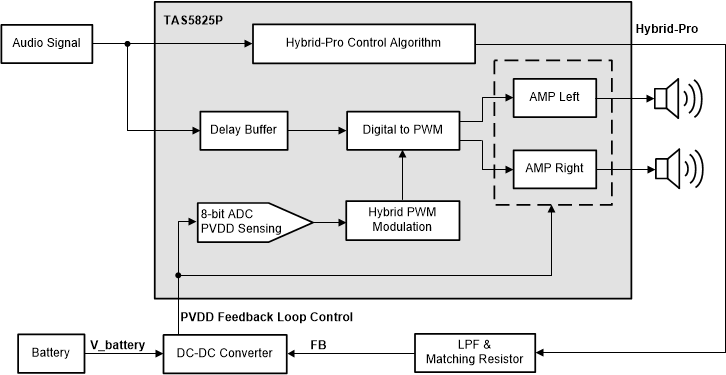SLASET9A May 2019 – January 2023 TAS5825P
PRODUCTION DATA
- 1 Features
- 2 Applications
- 3 Description
- 4 Revision History
- 5 Device Comparison Table
- 6 Pin Configuration and Functions
- 7 Specifications
- 8 Parameter Measurement Information
-
9 Detailed Description
- 9.1 Overview
- 9.2 Functional Block Diagram
- 9.3 Feature Description
- 9.4 Device Functional Modes
- 9.5 Programming and Control
- 9.6 Register Maps
-
10Application and Implementation
- 10.1 Application Information
- 10.2 Typical Applications
- 10.3 Power Supply Recommendations
- 10.4 Layout
- 11Device and Documentation Support
- 12Mechanical, Packaging, and Orderable Information
Package Options
Mechanical Data (Package|Pins)
- RHB|32
Thermal pad, mechanical data (Package|Pins)
- RHB|32
Orderable Information
3 Description
TAS5825P is a stereo high-efficiency Closed-Loop audio Class-D audio amplifier with an advanced Hybrid-Pro algorithm to improve system efficiency and reduce heat without clipping distortion.
The supply voltage (PVDD) of an audio amplifier is normally provided by a DC-DC converter. Compared with a fixed PVDD, a variable PVDD that fluctuates based on the audio signal significantly improves efficiency, lowers idle current, and reduces heat.
The powerful audio DSP core of TAS5825P implements a proprietary algorithm called Hybrid-Pro. The Hybrid-Pro algorithm detects the upcoming audio power demand and provides a PWM control signal for the former DC-DC converter via the Hybrid-Pro feedback pin (HPFB). The TAS5825P supports up to 4 ms of delay buffer to look ahead at the audio signal and prevent audio clipping distortion. In various experiments, the TAS5825P increased the runtime of 1S and 2S batteries by greater than 50% while continuously playing music.
| PART NUMBER | PACKAGE | BODY SIZE (NOM) |
|---|---|---|
| TAS5825P | VQFN (32) RHB | 5.00 mm × 5.00 mm |
